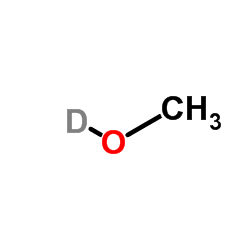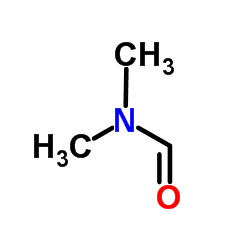Methan(2H)ol

Methan(2H)ol structure
|
Common Name | Methan(2H)ol | ||
|---|---|---|---|---|
| CAS Number | 4206-31-9 | Molecular Weight | 33.048 | |
| Density | 0.8±0.1 g/cm3 | Boiling Point | 48.1±3.0 °C at 760 mmHg | |
| Molecular Formula | CH3DO | Melting Point | N/A | |
| MSDS | Chinese USA | Flash Point | 11.1±0.0 °C | |
| Symbol |



GHS02, GHS06, GHS08 |
Signal Word | Danger | |
| Name | methyl-d1 alcohol |
|---|---|
| Synonym | More Synonyms |
| Density | 0.8±0.1 g/cm3 |
|---|---|
| Boiling Point | 48.1±3.0 °C at 760 mmHg |
| Molecular Formula | CH3DO |
| Molecular Weight | 33.048 |
| Flash Point | 11.1±0.0 °C |
| Exact Mass | 33.032490 |
| PSA | 20.23000 |
| LogP | -0.72 |
| Vapour Pressure | 265.4±0.1 mmHg at 25°C |
| Index of Refraction | 1.311 |
|
Section1. IDENTIFICATION OF THE SUBSTANCE/MIXTURE Product identifiers Product name: Methanol-1-d CAS-No.: 4206-31-9 Relevant identified uses of the substance or mixture and uses advised against Identified uses: Laboratory chemicals, Manufacture of substances Section2. HAZARDS IDENTIFICATION Classification of the substance or mixture Classification according to Regulation (EC) No 1272/2008 [EU-GHS/CLP] Flammable liquids (Category 2) Acute toxicity, Inhalation (Category 3) Acute toxicity, Dermal (Category 3) Acute toxicity, Oral (Category 3) Specific target organ toxicity - single exposure (Category 1) Classification according to EU Directives 67/548/EEC or 1999/45/EC Highly flammable. Toxic by inhalation, in contact with skin and if swallowed. Toxic: danger of very serious irreversible effects through inhalation, in contact with skin and if swallowed. Label elements Labelling according Regulation (EC) No 1272/2008 [CLP] Pictogram Signal wordDanger Hazard statement(s) H225Highly flammable liquid and vapour. H301Toxic if swallowed. H311Toxic in contact with skin. H331Toxic if inhaled. H370Causes damage to organs. Precautionary statement(s) P210Keep away from heat/sparks/open flames/hot surfaces. - No smoking. P260Do not breathe dust/ fume/ gas/ mist/ vapours/ spray. P280Wear protective gloves/ protective clothing. P301 + P310IF SWALLOWED: Immediately call a POISON CENTER or doctor/ physician. P311Call a POISON CENTER or doctor/ physician. Supplemental Hazardnone Statements According to European Directive 67/548/EEC as amended. Hazard symbol(s) R-phrase(s) R11Highly flammable. R23/24/25Toxic by inhalation, in contact with skin and if swallowed. R39/23/24/25Toxic: danger of very serious irreversible effects through inhalation, in contact with skin and if swallowed. S-phrase(s) S7Keep container tightly closed. S16Keep away from sources of ignition - No smoking. S36/37Wear suitable protective clothing and gloves. S45In case of accident or if you feel unwell, seek medical advice immediately (show the label where possible). Other hazards - none Section3. COMPOSITION/INFORMATION ON INGREDIENTS Substances Synonyms: Methanol-d1(methyl-d1) Methyl-d1 Alcohol Formula: CDH3O Molecular Weight: 33,05 g/mol ComponentConcentration Methan-d1-ol CAS-No.4206-31-9- Section4. FIRST AID MEASURES Description of first aid measures General advice Consult a physician. Show this safety data sheet to the doctor in attendance. If inhaled If breathed in, move person into fresh air. If not breathing, give artificial respiration. Consult a physician. In case of skin contact Wash off with soap and plenty of water. Take victim immediately to hospital. Consult a physician. In case of eye contact Flush eyes with water as a precaution. If swallowed Do NOT induce vomiting. Never give anything by mouth to an unconscious person. Rinse mouth with water. Consult a physician. Most important symptoms and effects, both acute and delayed Gastrointestinal disturbance, May cause convulsions. Indication of any immediate medical attention and special treatment needed no data available Section5. FIREFIGHTING MEASURES Extinguishing media Suitable extinguishing media Use water spray, alcohol-resistant foam, dry chemical or carbon dioxide. Special hazards arising from the substance or mixture Carbon oxides Advice for firefighters Wear self contained breathing apparatus for fire fighting if necessary. Further information Use water spray to cool unopened containers. Section6. ACCIDENTAL RELEASE MEASURES Personal precautions, protective equipment and emergency procedures Wear respiratory protection. Avoid breathing vapors, mist or gas. Ensure adequate ventilation. Remove all sources of ignition. Evacuate personnel to safe areas. Beware of vapours accumulating to form explosive concentrations. Vapours can accumulate in low areas. Environmental precautions Prevent further leakage or spillage if safe to do so. Do not let product enter drains. Methods and materials for containment and cleaning up Contain spillage, and then collect with an electrically protected vacuum cleaner or by wet-brushing and place in container for disposal according to local regulations (see section 13). Reference to other sections For disposal see section 13. Section7. HANDLING AND STORAGE Precautions for safe handling Avoid contact with skin and eyes. Avoid inhalation of vapour or mist. Keep away from sources of ignition - No smoking.Take measures to prevent the build up of electrostatic charge. Conditions for safe storage, including any incompatibilities Store in cool place. Keep container tightly closed in a dry and well-ventilated place. Containers which are opened must be carefully resealed and kept upright to prevent leakage. Store under inert gas. hygroscopic Specific end uses no data available Section8. EXPOSURE CONTROLS/PERSONAL PROTECTION Control parameters Components with workplace control parameters Exposure controls Appropriate engineering controls Avoid contact with skin, eyes and clothing. Wash hands before breaks and immediately after handling the product. Personal protective equipment Eye/face protection Face shield and safety glasses Use equipment for eye protection tested and approved under appropriate government standards such as NIOSH (US) or EN 166(EU). Skin protection Handle with gloves. Gloves must be inspected prior to use. Use proper glove removal technique (without touching glove's outer surface) to avoid skin contact with this product. Dispose of contaminated gloves after use in accordance with applicable laws and good laboratory practices. Wash and dry hands. The selected protective gloves have to satisfy the specifications of EU Directive 89/686/EEC and the standard EN 374 derived from it. Body Protection Complete suit protecting against chemicals, Flame retardant antistatic protective clothing, The type of protective equipment must be selected according to the concentration and amount of the dangerous substance at the specific workplace. Respiratory protection Where risk assessment shows air-purifying respirators are appropriate use a full-face respirator with multi-purpose combination (US) or type AXBEK (EN 14387) respirator cartridges as a backup to engineering controls. If the respirator is the sole means of protection, use a full-face supplied air respirator. Use respirators and components tested and approved under appropriate government standards such as NIOSH (US) or CEN (EU). Section9. PHYSICAL AND CHEMICAL PROPERTIES Information on basic physical and chemical properties a) AppearanceForm: liquid b) Odourno data available c) Odour Thresholdno data available d) pHno data available e) Melting point/freezingno data available point f) Initial boiling point and 65,4 °C - lit. boiling range g) Flash point11 °C - closed cup h) Evaporation rateno data available i) Flammability (solid, gas) no data available j) Upper/lowerno data available flammability or explosive limits k) Vapour pressureno data available l) Vapour densityno data available m) Relative density0,814 g/mL at 25 °C0,814 g/cm3 at 25 °C n) Water solubilityno data available o) Partition coefficient: n- no data available octanol/water p) Autoignitionno data available temperature q) Decompositionno data available temperature r) Viscosityno data available s) Explosive propertiesno data available t) Oxidizing propertiesno data available Other safety information no data available Section10. STABILITY AND REACTIVITY Reactivity no data available Chemical stability no data available Possibility of hazardous reactions no data available Conditions to avoid Heat, flames and sparks. Extremes of temperature and direct sunlight. Incompatible materials no data available Hazardous decomposition products Section11. TOXICOLOGICAL INFORMATION Information on toxicological effects Acute toxicity Skin corrosion/irritation no data available Serious eye damage/eye irritation no data available Respiratory or skin sensitization no data available Germ cell mutagenicity no data available Carcinogenicity IARC:No component of this product present at levels greater than or equal to 0.1% is identified as probable, possible or confirmed human carcinogen by IARC. Reproductive toxicity no data available Specific target organ toxicity - single exposure Causes damage to organs. Specific target organ toxicity - repeated exposure no data available Aspiration hazard no data available Potential health effects Inhalation Toxic if inhaled. May cause respiratory tract irritation. IngestionToxic if swallowed. Skin Toxic if absorbed through skin. May cause skin irritation. EyesMay cause eye irritation. Signs and Symptoms of Exposure Gastrointestinal disturbance, May cause convulsions. Additional Information RTECS: Not available Section12. ECOLOGICAL INFORMATION Toxicity no data available Persistence and degradability no data available Bioaccumulative potential no data available Mobility in soil no data available Results of PBT and vPvB assessment no data available Other adverse effects no data available Section13. DISPOSAL CONSIDERATIONS Waste treatment methods Product Burn in a chemical incinerator equipped with an afterburner and scrubber but exert extra care in igniting as this material is highly flammable. Offer surplus and non-recyclable solutions to a licensed disposal company. Contaminated packaging Dispose of as unused product. Section14. TRANSPORT INFORMATION UN number ADR/RID: 1230IMDG: 1230IATA: 1230 UN proper shipping name ADR/RID: METHANOL IMDG: METHANOL IATA:Methanol Transport hazard class(es) ADR/RID: 3 (6.1)IMDG: 3 (6.1)IATA: 3 (6.1) Packaging group ADR/RID: IIIMDG: IIIATA: II Environmental hazards ADR/RID: noIMDG Marine pollutant: noIATA: no Special precautions for user no data available SECTION 15 - REGULATORY INFORMATION N/A SECTION 16 - ADDITIONAL INFORMATION N/A |
| Symbol |



GHS02, GHS06, GHS08 |
|---|---|
| Signal Word | Danger |
| Hazard Statements | H225-H301 + H311 + H331-H370 |
| Precautionary Statements | P210-P280-P302 + P352 + P312-P304 + P340 + P312-P370 + P378-P403 + P235 |
| Hazard Codes | F: Flammable;T: Toxic; |
| Risk Phrases | 11-23/25 |
| Safety Phrases | 7-16-24-45 |
| RIDADR | UN 1230 3/PG 2 |
|
~% 
Methan(2H)ol CAS#:4206-31-9 |
| Literature: Liu, Yumin; Schwartz, Jeffrey Journal of Organic Chemistry, 1993 , vol. 58, # 18 p. 5005 - 5007 |
|
~% 
Methan(2H)ol CAS#:4206-31-9 |
| Literature: Kabisch, G.; Moebius, G. Spectrochimica Acta, Part A: Molecular and Biomolecular Spectroscopy, 1982 , vol. 38, # 11 p. 1189 - 1194 |
| Precursor 2 | |
|---|---|
| DownStream 1 | |
|
Fine tuning of 4,6-bisphenyl-2-(3-alkoxyanilino)pyrimidine focusing on the activity-sensitive aminoalkoxy moiety for a therapeutically useful inhibitor of receptor for advanced glycation end products (RAGE).
Bioorg. Med. Chem. 23(3) , 579-87, (2015) Through the fine tuning of the activity-sensitive aminoalkoxy moiety of 4,6-bisphenyl-2-(3-alkoxyanilino)pyrimidine as a novel inhibitor of the receptor for advanced glycation end products (RAGE), the... |
|
|
Dynamics of dissolved and particulate polyunsaturated aldehydes in mesocosms inoculated with different densities of the diatom Skeletonema marinoi.
Mar. Drugs 9 , 345-58, (2011) A survey of the production of polyunsaturated aldehydes (PUA) of manipulated plankton communities is presented here. PUA are phytoplankton-derived metabolites that are proposed to play an important ro... |
|
|
Synthesis of the Proposed Structure of Damaurone D and Evaluation of Its Anti-inflammatory Activity.
Chem. Pharm. Bull. 63 , 907-12, (2015) Concise and efficient synthesis of the proposed structure of damaurone D is accomplished in five steps without protection-deprotection operations. The key feature of our synthesis includes a versatile... |
| Methan-d1-ol,Methanol-d1,methyl-d1) |
| deuteroformyl radical |
| Methanol-d |
| deuterioformyl |
| Methyl-d1 radical,oxo |
| monodeuteriomethanol |
| methyl-d alcohol |
| C-deuterio-methanol |
| deuteromethanol |
| deuteriomethanol |
| Methan(H)ol |


 CAS#:992-96-1
CAS#:992-96-1